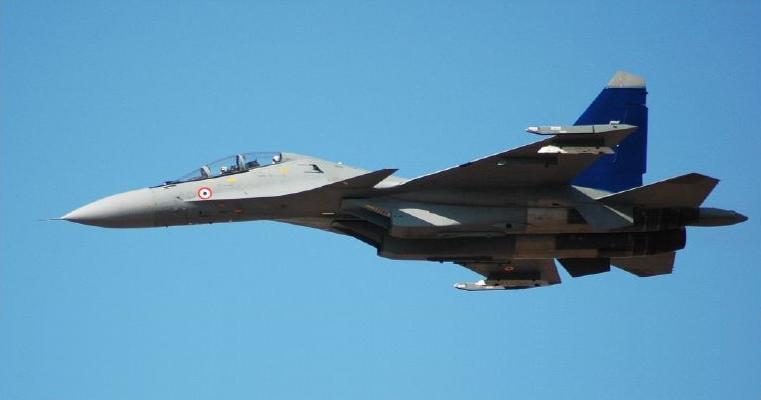The Su-30MKI is one of the most powerful fighter aircraft with the Indian Air Force. It was in October 2000, when India signed a Memorandum of Understanding (MoU) with Russia to start license production of the fighter jet at HAL’s plant.
European F-35s: Will Meteor & Spear Missiles Make UK, Italy’s F-35 Stealth Jets Superior To The Americans’?
Video Resurfaces When World’s Most Powerful Aircraft – F-22 Raptor Was ‘Shot-Down’ By Rafale Fighter Jet
Prior to the MoU, these fighter jets were produced at Irkutsk Aircraft Production Association (now known as Irkut Corporation). The Sukhoi Su-30MKI incorporates an aerodynamic airframe made of titanium and high-intensity aluminum alloys.
The aircraft has a length of 21.9m, a wingspan of 14.7m, and a height of 6.4m. The maximum take-off weight of Su-30MKI is 38,800kg.

The Su-30MKI is now armed with the air-launched version of BrahMos supersonic cruise missile (jointly developed by India and Russia), which was successfully tested in November 2017.
The BrahMos can strike targets within a range of 290km. The IAF completed the successful integration of the cruise missile on the fighter, with the third live-firing of the missile from the aircraft held in December 2019.
At present, the IAF operates 272 (approx) Su-30MKI fighter jets. India is also the largest operator of export-oriented Su-30MKI across the world.
India’s Most Powerful Jets In Kashmir
The IAF is holding a mega airshow in the Kashmir Valley — a region Pakistan calls disputed and where both the nations have fought many wars, and skirmishes along the border are frequent.
Reports suggest that IAF is keen to motivate the youth of the tumultuous region to join the service. As part of the event, IAF’s Sukhoi Su-30 MKI fighter jets among others will perform in the airshow.
The last IAF airshow in the region was held in 2008. No such event was held in the past decade due to constant turmoil in the Valley.
IAF officials have confirmed that the service is going to conduct an air show over the famous Dal Lake in Srinagar on September 26. Besides Sukhoi Su-30 MKI fighter jets, MiG-21 Bisons are going to be another major attraction at the event.
IAF’s skydiving team ‘Akash Ganga’, Suryakiran Aerobatic and Display Team and paramotor flying will be conducting what is expected to be jaw-dropping maneuvers in the skies over Dal Lake, officials said.
The event, being jointly organized by the Air Force Station Srinagar and Jammu and Kashmir administration, is part of the ongoing celebrations, “Azadi ka Amrit Mahotsav” to commemorate the 75th anniversary of India’s independence.
According to reports, the main theme of the exercise is “Give Wings to Your Dreams”, aimed at motivating the youth across the valley to join the IAF as well as boosting tourism in the region.
The event will be flagged off by Jammu and Kashmir Lieutenant-Governor Manoj Sinha at the Sher-e-Kashmir International Conference Centre (SKICC) overlooking Dal Lake.
“The main aim of the airshow is to motivate the youth of the Valley to join the Indian Air Force and to promote tourism in the region”, Divisional Commissioner, Kashmir, Pandurang K Pole said. The airshow will be attended by approximately 3000 school and college students
Su-30MKI Vs Pakistan Air Force
On February 26, 2019, the Pakistan Air Force (PAF) deployed around 24 fighter jets including F-16s and JF-17s, following India’s airstrike on ‘terror camps’ in Balakot.
In response, the IAF scrambled eight fighter aircraft, including two Sukhoi-30 MKI, to intercept the Pakistani F16s, which had fired AIM-120 C5 Advanced Medium-Range Air-to-Air Missiles (AMRAAMs).
The Su-30MKIs were the primary target for the F-16s, which were tasked to shoot down at least one Rusian-origin aircraft. Bringing down a Su-30MKI would have brought unprecedented recognition for the Pakistani pilots.

According to the veteran Air Force aviator Sameer Joshi, the PAF was of the belief that the loss of a Su-30MKI would effectually put the IAF on a backfoot and severely down the Indian morale.
Joshi said the eight F-16s were in two formations of 4 each. The north group of 4 F-16s engaged the Indian jets, which fired 3 AIM-120C AMRAAM missiles.
All the missiles missed their mark. The Sukhois pushed them back, while also picking up another group of 4 F-16s “and multiple inbound strike aircraft” from the southern formation.
This, in essence, meant that the Indian jets were massively outgunned by the PAF formation carrying more advanced BVR missiles and in sheer numbers. A fourth AMRAAM was fired by the south group.
By advanced mapping, it could be inferred that by that time the Su-30MKI jets were just 25-30 km away from the north group jets. This fourth AMRAAM was also evaded by the Sukhois.
Joshi mentions that the two Su-30MKIs, instead of retreating, counterattacked against the F-16s “ignoring the high-density BVR threat from the F-16s, in all probability breaching the AMRAAM MAR to press home the R27/77 attack 25-30 km from lead PAF jets in the North Group”.

This meant that the things turned out to be the other way for the PAF, the Su-30s instead of returning dashed on to the F-16s to make them come under the R-27/77 missile range.
Interestingly, according to Joshi, the lead north group F-16 fighters, instead of attacking the incoming Sukhoi, went ‘COLD’ prematurely. Joshi concludes that the reason for the 10 out of 12 Pakistani bombs falling well out of the range of their intended targets was because of this unexpected counterattack by the IAF fighters.
Other aircraft were hurried to the location, including Mirage-2000 and MiG-21 Bison, which resulted in the famous F-16 and MiG-21 incident.
“The PAF jets clinically kept themselves safe from the IAF AAMs and their known engagement envelopes. The dash of the Sukhois was something, which may have taken the PAF by surprise, hence the various possibilities as enumerated above. Lessons for both sides from this BVR encounter,” Joshi added.
- Nitin holds a double master’s degree in Journalism and Business Management (MBA) from The University of Glasgow, UK. He has over 15 years of global experience in Marketing & Communications, Journalism, and Digital Marketing and widely worked & traveled across Europe, the Americas and Asia. CONTACT: Nytten@gmail.com
- Follow EurAsian Times on Google News




